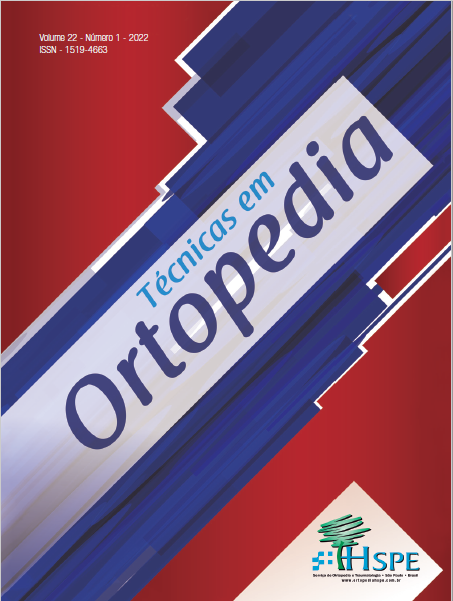Ausência de pulso e perfusão periférica pós redução de fratura supracondiliana em criança
Keywords:
fraturas do úmero; fraturas ósseas; pulso; criança.Abstract
Supracondylar fracture is the most common site in children’s humerus. Surgery is indicated in serious cases avoiding possible sequelae. Impairment of the vascular perfusion of the member is a possible complication, demanding attention of the surgeon. A 9 years old boy with supracondylar extension fracture Gartland III and absence of radial and ulnar pulsesafter closed reduction, as there was not reperfusion of the member, open reduction was performed with surgical exploration and release of the neurovascular bundle. Accordingto the literature,absence of the peripheral pulses after closed reduction leads to surgical exploration and open reduction, this tendency seems to be bigger when associated with angiography or arterial Doppler. As presented by Delniotis et al., the use of arterial Doppler, associated with intraoperative physical examination, leads to open surgical exploration with a good result.
Downloads
References
Farnsworth CL, Silva PD, Mubarak SJ. Etiology of supracondylar humerus fractures. J Pediatr Orthop.1998;18(1):38-42.
Abzug JM, Herman MJ. Management of supracondylar humerus fractures in children: Current concepts. J Am Acad Orthop Surg. 2012;20(2):69-77.
Wilkins KE: Supracondylar fractures: what’s new? J Pediatr Orthop B.1997; 6(2):110-6.
Gartland JJ. Management of supracondylar fractures of the humerus in children. Surg Gynecol Obstet. 1959;109:145-154.
Müller ME, Nazarian S, Koch P, Schatzker J. Berlin, Heidelberg: Springer; 1990. The Comprehensive Classification of Fractures.
Badkoobehi H, Choi PD, Bae DS, Skaggs DL. Management of the pulseless pediatric supracondylar humeral fracture. J Bone Joint Surg Am. 2015;97(11):937-43.
Garg S, Weller A, Larson AN, Fletcher ND, Kwon M, Schiller J, et al. Clinical characteristics of severe supracondylar humerus fractures in children. J Pediatr Orthop. 2014;34(1):34-39.
Choi PD, Melikian R, Skaggs DL. Risk factors for vascular repair and compartment syndrome in the pulseless supracondylar humerus fracture in children. J Pediatr Orthop. 2010;30(1): 50-6.
Shore BJ, Gillespie BT, Miller PE, Bae DS, Waters PM. Recovery of motor nerve injuries associated with displaced, extensiontype pediatric supracondylar humerus fractures. J Pediatr Orthop. 2019;39(9):e652-e6.
Mitchell SL, Sullivan BT, Ho CA, Abzug JM, Raad M, Sponseller PD. Pediatric Gartland Type-IV Supracondylar Humeral Fractures Have Substantial Overlap with Flexion-Type Fractures. J Bone Joint Surg Am. 2019;101(15):1351-6.
Sabharwal S, Margalit A, Swarup I, Sabharwal S. The Pulseless Supracondylar Elbow Fracture: A Rational Approach. Indian J Orthop. 2020;55(1):47-54.
Delniotis I, Delniotis A, Saloupis P, Gavriilidou A, Galanis N, Kyriakou A, et al. Management of the Pediatric Pulseless Supracondylar Humeral Fracture: A Systematic Review and Comparison study of ‘watchful expectancy strategy’ versus surgical exploration of the brachial artery. Ann Vasc Surg. 2019;55:260-71.
Omid R, Choi PD, Skaggs DL. Supracondylar humeral fractures in children. J Bone Joint Surg Am. 2008;90(5):1121-32.
Waters, PM, Skaggs, DL, Flynn, JM. Rockwood and Wilkins’ Fractures in Children. 9th ed. Philadelphia: Wolters Kluwer; 2020.
Louahem DM, Nebunescu A, Canavese F, Dimeglio A. Neurovascular complications and severe displacement in supracondylar humerus fractures in children: defensive or offensive strategy? J Pediatr Orthop B. 2006;15(1):51-7.





